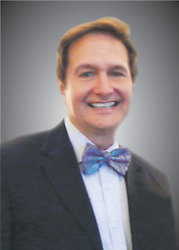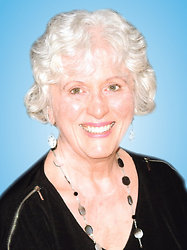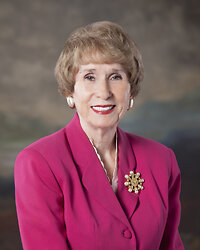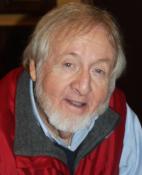BRAINS AND BEAUTY
The surprising legacy of Hedy Lamarr
by Rob Lauer

Movies have always been obsessed with feminine beauty, as is evidenced in a musical number from the 1941 film Ziegfeld Girl.
In it, then-popular singer Tony Martin stands at the foot of a staircase that gracefully extends upward toward heaven. While a procession of lovely showgirls descends the steps, Martin worshipfully sings to them: "You stepped out of a dream; you are too beautiful to be what you seem." As the number reaches its climax, Martin offers the song's final strains to one particular young woman whose beauty can justifiably be described as breath-taking.
Tall, slender, and regal, the porcelain perfection of her face is in stark contrast to her raven hair, eyebrows, and lashes. The film's black and white photography cannot hide the shimmering luminosity of her green eyes. She holds her chin high without a trace of artificiality. The spray of silver stars, haloing her head, give her the ethereal, untouchable quality of a goddess. This is Hedy Lamarr-a new star at the time whom the press had christened "The Most Beautiful Woman in the World." As the song ends, Hedy looks outward, upward toward the heavens. The number is impressive, but Hedy's glamour and face are what audiences remember.
Other movie stars may have dreamt of being cinematically immortalized in such a scene, but Hedy shrugged it off. "Any girl can be glamorous," she later said. "All you have to do is stand still and look stupid."
In a day when women were often judged solely by their looks, Hedy's remark was likely taken as self-deprecating or a sign of intellectual insecurity. But Hedy Lamar was neither self-deprecating nor intellectually insecure-thanks to her Austrian Jewish parents, who had valued cultivating her mind more than focusing on her natural good looks.
She had been born Hedwig Kiesler in Vienna, Austria, in 1914. As a small child, she often walked hand-in-hand with her father through the busy city streets as he pointed out architectural elements on buildings and explained the engineering principles involved in their construction. This ignited her intense interest in mechanics, mathematics, chemistry, and technology. Her mother, a former concert pianist, nurtured her love of the arts. As a teen, Hedy decided to pursue a career as a film actress, but she never lost her passion for hard science.
In 1933, at age 18, Hedy married 33-year-old Friedrich Mandl, a military munitions manufacturer and the third-richest man in Austria. Her parents disapproved due to Mandl's ties to Benito Mussolini and Adolph Hitler.
Mandl expected Hedy to quit her acting career and be a proper trophy wife. "He was the absolute monarch in his marriage," Hedy later recalled. "I was like a doll, a thing, some object of art which had to be guarded-and imprisoned-having no mind, no life of its own."
While Mandl assumed his lovely young wife was incapable of understanding his dinner conversation with guests, she silently absorbed discussions on weapons technology and inwardly recoiled when the talk turned political. Realizing that her husband supported the rise of European Fascism, Hedy decided to escape her marriage and her homeland. Because Mandl was so controlling, this required disguising herself as one of their housemaids and stealing away in the middle of the night.
She made her way to London just as MGM-the world's leading movie studio-was auditioning European actors. She refused the modest-paying standard contract initially offered by the studio and negotiated for more money. She got it, along with a new last name-Lamarr.
Arriving in Hollywood in 1938, she was immediately cast in A-list films opposite the day's top leading men. Her cultured Austrian accent and dark exotic beauty made her an overnight sensation. But as Hedy's showbiz star rose, she watched in horror as Europe fell to Fascism and Nazism, igniting World War II.
During the first years of the war, Nazi Germany seemed invincible-particularly at sea. German subs could hack into and jam the radio frequencies guiding Allied torpedoes, rendering them useless. Obsessed with finding a way to stop Germany, Hedy tackled the problem herself.
Unknown to everyone but a small circle of friends, Hedy had designated a room in her Beverly Hills home as her "inventing room," where she indulged her passion for science. Here, she developed an idea for undermining Germany's torpedo jamming technology. Hedy reasoned that a torpedo guided by frequencies that constantly changed multiple times per second would be much harder to jam.
At a dinner party one evening, she shared her idea with a close friend, film composer George Antheil. Also possessing a passion for science and technology, Antheil volunteered to help Hedy. Their joint invention synchronized changes between 88 frequencies and called for a high-altitude observation plane to steer a radio-controlled torpedo from above. Hedy and Antheil obtained a patent on their device in 1942 and donated it to the Navy, convinced their new "spread spectrum" technology was groundbreaking.
To their dismay, the government showed no interest. Officials told then 27-year-old Hedy that instead of trying to develop new weapon technologies, she could better help the war effort by using her good looks and star power to sell war bonds. Hedy was essentially told that she couldn't be beautiful and smart. So, not yet a U.S. citizen, she voluntarily hit the road to sell war bonds. Adjusted for inflation, she raised $343 million for the war effort while her invention remained ignored for more than 20 years.
Three years after Hedy and Antheil's patent expired, the Navy finally put their technology to use during the 1962 blockade of Cuba. In the years that followed, Hedy's spread-spectrum technology became the basis for the Wifi and Bluetooth technologies that have revolutionized every aspect of global communication.
In the late 1990s, as the digital revolution took off, Hedy finally received recognition and awards for her work, including the 1997 Pioneer Award from the Electronic Frontier Foundation. After her death in 2000, she was posthumously inducted into the National Inventors Hall of Fame for her frequency-hopping spread spectrum technology.
Deeply appreciative of the belated recognition, she nevertheless regretted that she wasn't taken seriously for most of her life because of her looks. "My face is a mask I cannot remove," she said. "I must always live with it. I curse it."
And yet, she was not bitter. During her final years, she often left her adult children uplifting quotes on their phone answering machines. One of her favorites was from a poem by Kent Smith:
"Give the world the best you have
and you'll get kicked in the teeth.
Give the world the best you have anyway."
and you'll get kicked in the teeth.
Give the world the best you have anyway."
The Shopper
1545 Crossways Blvd.
Chesapeake, VA 23320
757-317-5465
http://www.TheShopper.com
CURRENT COLUMNS
On The Front Porch With You 
Memories of Homeby Rob LauerPublisher’s Point 
Time To Moveby Jean Loxley-BarnardChildren First 
Dandelion Timeby Becky AdamsRelationships 
When Your Security Blanket is in the Dryerby Dr. Bill Austin
